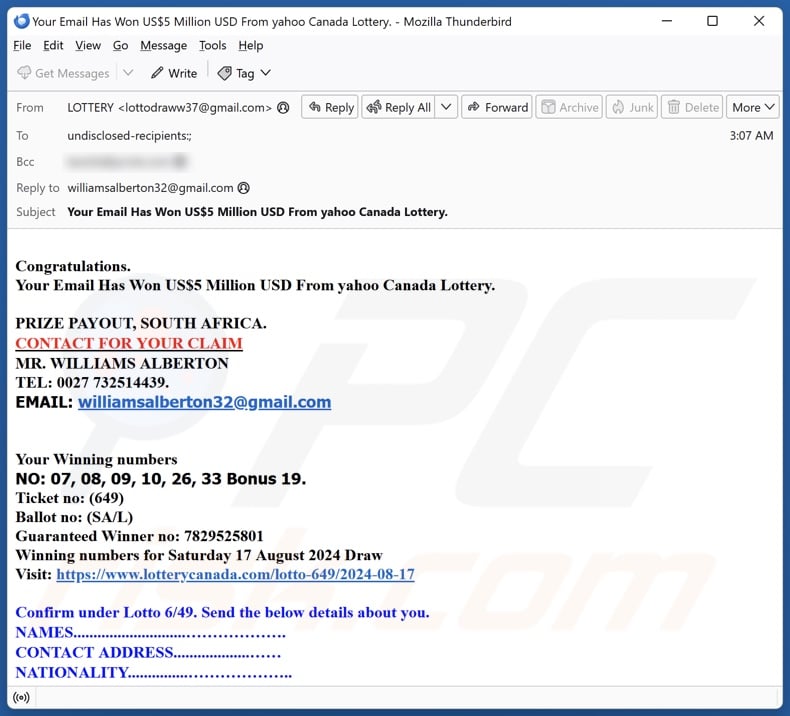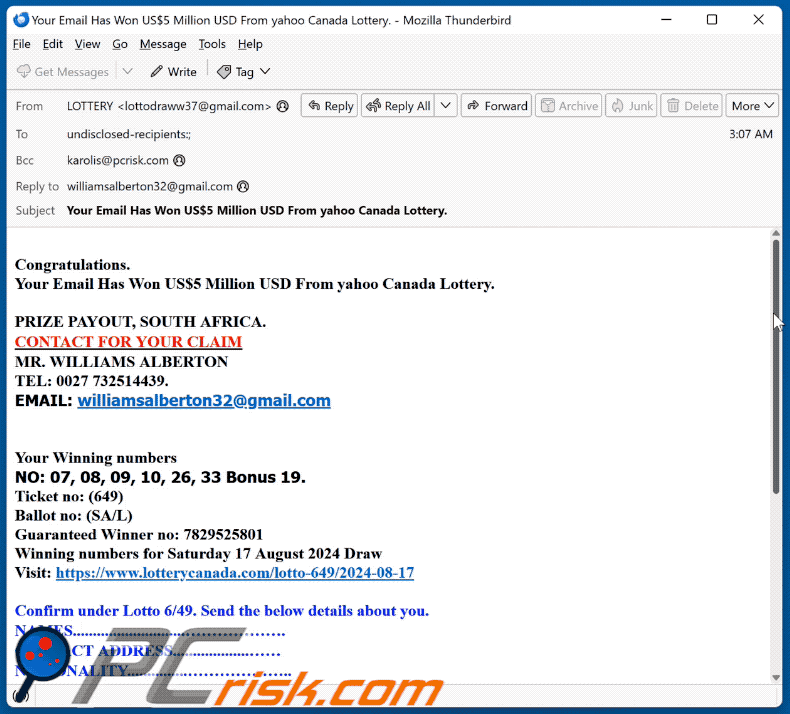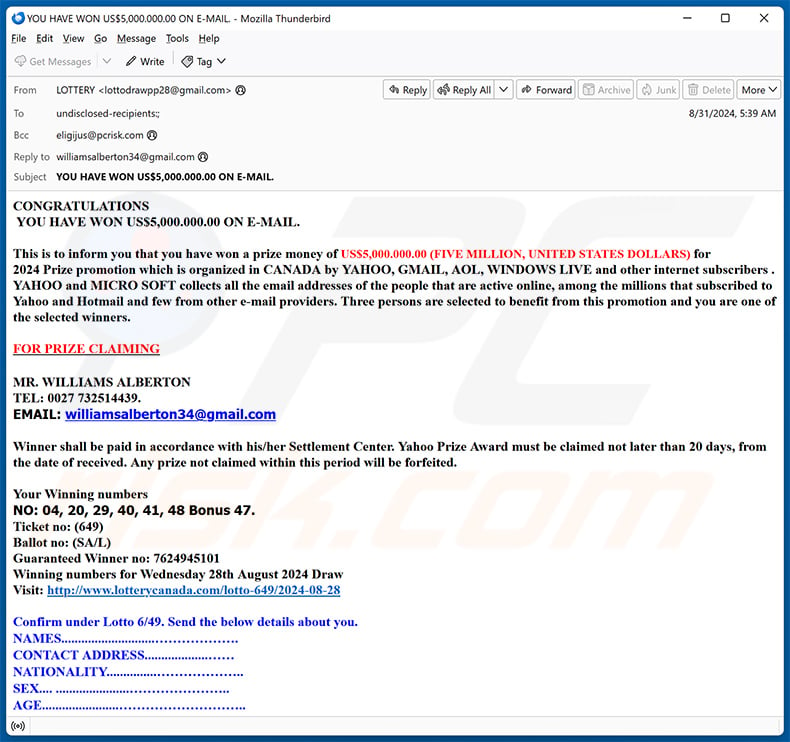Avoid getting scammed by fake "Yahoo Canada Lottery" emails
Phishing/ScamAlso Known As: "Yahoo Canada Lottery" phishing email
Get free scan and check if your device is infected.
Remove it nowTo use full-featured product, you have to purchase a license for Combo Cleaner. Seven days free trial available. Combo Cleaner is owned and operated by RCS LT, the parent company of PCRisk.com.
What kind of email is "Yahoo Canada Lottery"?
After reading the "Yahoo Canada Lottery" email, we determined that it is spam. The fake letter claims that the recipient has won 5 million USD in a lottery. The phishing email instructs to provide personally identifiable information to claim the prize. In addition to targeting private data, this spam mail may also seek funds.

"Yahoo Canada Lottery" email scam overview
The spam email with the subject "Your Email Has Won US$5 Million USD From yahoo Canada Lottery." (may vary) congratulates the recipient on winning the "yahoo Canada Lottery". Their prize is five million US dollars. The scam letter details the win by providing the winning numbers, as well as the numbers for the supposed ticket and ballot.
It must be emphasized that the claims made by the email are false, and this mail is in no way associated with Yahoo! Inc. or any legitimate Canadian lotteries.
The letter requests the recipient to send their information to the claims agent, i.e., their name, age, sex, nationality, address, occupation, company, mobile phone and fax numbers. Personally identifiable data can be used to carry out various incredibly harmful activities, and that includes stealing victims' identities.
Additionally, scammers can ask "winners" to make bogus payments, such as handling taxes or fees. Cyber criminals rely on difficult-to-trace methods for fund acquisition, e.g., cryptocurrencies, cash hidden in packages and shipped, gift cards, etc. Hence, chances of successfully prosecuting scammers and retrieving the money are diminished.
In summary, victims of scam mail like "Yahoo Canada Lottery" can experience serious privacy issues, financial losses, and identity theft.
If you have disclosed your personally identifiable or finance-related data to scammers – immediately contact the appropriate authorities.
| Name | "Yahoo Canada Lottery" phishing email |
| Threat Type | Phishing, Scam, Social Engineering, Fraud |
| Fake Claim | Recipient has won 5 million USD in a lottery. |
| Disguise | Yahoo |
| Symptoms | Unauthorized online purchases, changed online account passwords, identity theft, illegal access of the computer. |
| Distribution methods | Deceptive emails, rogue online pop-up ads, search engine poisoning techniques, misspelled domains. |
| Damage | Loss of sensitive private information, monetary loss, identity theft. |
| Malware Removal (Windows) |
To eliminate possible malware infections, scan your computer with legitimate antivirus software. Our security researchers recommend using Combo Cleaner. Download Combo CleanerTo use full-featured product, you have to purchase a license for Combo Cleaner. 7 days free trial available. Combo Cleaner is owned and operated by RCS LT, the parent company of PCRisk.com. |
Phishing spam campaign examples
We have analyzed countless spam campaigns; "Samsung Prize Money", "Foreign Beneficiary", "BMW Promotional Program", "Nedbank email scam", and "SharePoint - ACH-Wire Authorization" are just some examples of phishing emails.
In addition to personally identifiable information, these letters commonly target log-in credentials and finance-related data. However, various scams are promoted through spam mail, and it is used to distribute malware.
While the widely held belief that these emails are poorly written and full of grammatical/spelling errors is not untrue, it is not always the case. This mail can be competently crafted and even believably disguised as messages from legitimate companies, service providers, organizations, authorities, and other entities.
How do spam campaigns infect computers?
Cyber criminals often use spam campaigns to proliferate malware. These emails/messages can include malicious files as attachments or download links. Virulent files come in various formats, e.g., archives (ZIP, RAR, etc.), executables (.exe, .run, etc.), documents (Microsoft Office, Microsoft OneNote, PDF, etc.), JavaScript, and so on.
The malware download/installation chain is initiated once a file is opened. Some formats require additional user interaction to initiate system infection processes. For example, Microsoft Office files need users to enable macro commands (i.e., editing/content), while OneNote documents require them to click embedded links or files.
How to avoid installation of malware?
It is essential to approach incoming emails, DMs/PMs, SMSes, and other messages with caution. We advise against opening attachments or links present in suspicious mail, as they can be harmful or infectious.
It must be mentioned that malware is spread using various techniques. Therefore, we recommend being careful while browsing, as the Internet is full of fraudulent and malicious content.
Furthermore, all downloads must be made from official and verified sources. Another recommendation is to activate and update programs using functions/tools provided by legitimate developers, as illegal activation ("cracking") tools and third-party updaters can contain malware.
It is paramount for device/user safety to have a reputable anti-virus installed and kept up-to-date. This software must be used to perform regular system scans and to remove detected threats and issues. If you've already opened malicious attachments, we recommend running a scan with Combo Cleaner Antivirus for Windows to automatically eliminate infiltrated malware.
Text presented in the "Yahoo Canada Lottery" email letter:
Subject: Your Email Has Won US$5 Million USD From yahoo Canada Lottery.
Congratulations.
Your Email Has Won US$5 Million USD From yahoo Canada Lottery.
PRIZE PAYOUT, SOUTH AFRICA.
CONTACT FOR YOUR CLAIM
MR. WILLIAMS ALBERTON
TEL: 0027 732514439.
EMAIL: williamsalberton32@gmail.com
Your Winning numbers
NO: 07, 08, 09, 10, 26, 33 Bonus 19.
Ticket no: (649)
Ballot no: (SA/L)
Guaranteed Winner no: 7829525801
Winning numbers for Saturday 17 August 2024 Draw
Visit: hxxps://www.lotterycanada.com/lotto-649/2024-08-17
Confirm under Lotto 6/49. Send the below details about you.
NAMES............................……………….
CONTACT ADDRESS...................……
NATIONALITY...............………………..
SEX.... ......................…………………..
AGE.......................……………………..
PHONE / MOBILE NO: .......................
FAX……………………….....................
OCCUPATION.................................
COMPANY...............................……
Your email Attached to Ticket No. (6/49) and Ballot No: (SA/L)
Congratulations!! Once again.
Yours in service,
CONTACT YOUR CLAIM AGENT
NAME: MR WILLIAMS ALBERTON
TEL:0027 732514439.
Appearance of the "Yahoo Canada Lottery" spam email (GIF):

Another example of an email from "Yahoo Canada Lottery" email scam:

Text presented within:
Subject: YOU HAVE WON US$5,000.000.00 ON E-MAIL.
CONGRATULATIONS
YOU HAVE WON US$5,000.000.00 ON E-MAIL.
This is to inform you that you have won a prize money of US$5,000.000.00 (FIVE MILLION, UNITED STATES DOLLARS) for 2024 Prize promotion which is organized in CANADA by YAHOO, GMAIL, AOL, WINDOWS LIVE and other internet subscribers .
YAHOO and MICRO SOFT collects all the email addresses of the people that are active online, among the millions that subscribed to Yahoo and Hotmail and few from other e-mail providers. Three persons are selected to benefit from this promotion and you are one of the selected winners.FOR PRIZE CLAIMING
MR. WILLIAMS ALBERTON
TEL: 0027 732514439.
EMAIL: williamsalberton34@gmail.com
Winner shall be paid in accordance with his/her Settlement Center. Yahoo Prize Award must be claimed not later than 20 days, from the date of received. Any prize not claimed within this period will be forfeited.
Your Winning numbers
NO: 04, 20, 29, 40, 41, 48 Bonus 47.
Ticket no: (649)
Ballot no: (SA/L)
Guaranteed Winner no: 7624945101
Winning numbers for Wednesday 28th August 2024 Draw
Visit: hxxp://www.lotterycanada[.]com/lotto-649/2024-08-28
Confirm under Lotto 6/49. Send the below details about you.
NAMES............................……………….
CONTACT ADDRESS...................……
NATIONALITY...............………………..SEX.... ......................…………………..
AGE.......................………………………..
PHONE / MOBILE NO: .............................FAX……………………….....................
OCCUPATION.................................COMPANY...............................……
Your email Attached to Ticket No. (649) and Ballot No: (SA/L)
Congratulations!! Once again.
Yours in service,CONTACT YOUR CLAIM AGENT
NAME: MR WILLIAMS ALBERTON
Instant automatic malware removal:
Manual threat removal might be a lengthy and complicated process that requires advanced IT skills. Combo Cleaner is a professional automatic malware removal tool that is recommended to get rid of malware. Download it by clicking the button below:
DOWNLOAD Combo CleanerBy downloading any software listed on this website you agree to our Privacy Policy and Terms of Use. To use full-featured product, you have to purchase a license for Combo Cleaner. 7 days free trial available. Combo Cleaner is owned and operated by RCS LT, the parent company of PCRisk.com.
Quick menu:
- What is "Yahoo Canada Lottery" phishing email?
- Types of malicious emails.
- How to spot a malicious email?
- What to do if you fell for an email scam?
Types of malicious emails:
![]() Phishing Emails
Phishing Emails
Most commonly, cybercriminals use deceptive emails to trick Internet users into giving away their sensitive private information, for example, login information for various online services, email accounts, or online banking information.
Such attacks are called phishing. In a phishing attack, cybercriminals usually send an email message with some popular service logo (for example, Microsoft, DHL, Amazon, Netflix), create urgency (wrong shipping address, expired password, etc.), and place a link which they hope their potential victims will click on.
After clicking the link presented in such email message, victims are redirected to a fake website that looks identical or extremely similar to the original one. Victims are then asked to enter their password, credit card details, or some other information that gets stolen by cybercriminals.
![]() Emails with Malicious Attachments
Emails with Malicious Attachments
Another popular attack vector is email spam with malicious attachments that infect users' computers with malware. Malicious attachments usually carry trojans that are capable of stealing passwords, banking information, and other sensitive information.
In such attacks, cybercriminals' main goal is to trick their potential victims into opening an infected email attachment. To achieve this goal, email messages usually talk about recently received invoices, faxes, or voice messages.
If a potential victim falls for the lure and opens the attachment, their computers get infected, and cybercriminals can collect a lot of sensitive information.
While it's a more complicated method to steal personal information (spam filters and antivirus programs usually detect such attempts), if successful, cybercriminals can get a much wider array of data and can collect information for a long period of time.
![]() Sextortion Emails
Sextortion Emails
This is a type of phishing. In this case, users receive an email claiming that a cybercriminal could access the webcam of the potential victim and has a video recording of one's masturbation.
To get rid of the video, victims are asked to pay a ransom (usually using Bitcoin or another cryptocurrency). Nevertheless, all of these claims are false - users who receive such emails should ignore and delete them.
How to spot a malicious email?
While cyber criminals try to make their lure emails look trustworthy, here are some things that you should look for when trying to spot a phishing email:
- Check the sender's ("from") email address: Hover your mouse over the "from" address and check if it's legitimate. For example, if you received an email from Microsoft, be sure to check if the email address is @microsoft.com and not something suspicious like @m1crosoft.com, @microsfot.com, @account-security-noreply.com, etc.
- Check for generic greetings: If the greeting in the email is "Dear user", "Dear @youremail.com", "Dear valued customer", this should raise suspiciousness. Most commonly, companies call you by your name. Lack of this information could signal a phishing attempt.
- Check the links in the email: Hover your mouse over the link presented in the email, if the link that appears seems suspicious, don't click it. For example, if you received an email from Microsoft and the link in the email shows that it will go to firebasestorage.googleapis.com/v0... you shouldn't trust it. It's best not to click any links in the emails but to visit the company website that sent you the email in the first place.
- Don't blindly trust email attachments: Most commonly, legitimate companies will ask you to log in to their website and to view any documents there; if you received an email with an attachment, it's a good idea to scan it with an antivirus application. Infected email attachments are a common attack vector used by cybercriminals.
To minimise the risk of opening phishing and malicious emails we recommend using Combo Cleaner Antivirus for Windows.
Example of a spam email:

What to do if you fell for an email scam?
- If you clicked on a link in a phishing email and entered your password - be sure to change your password as soon as possible. Usually, cybercriminals collect stolen credentials and then sell them to other groups that use them for malicious purposes. If you change your password in a timely manner, there's a chance that criminals won't have enough time to do any damage.
- If you entered your credit card information - contact your bank as soon as possible and explain the situation. There's a good chance that you will need to cancel your compromised credit card and get a new one.
- If you see any signs of identity theft - you should immediately contact the Federal Trade Commission. This institution will collect information about your situation and create a personal recovery plan.
- If you opened a malicious attachment - your computer is probably infected, you should scan it with a reputable antivirus application. For this purpose, we recommend using Combo Cleaner Antivirus for Windows.
- Help other Internet users - report phishing emails to Anti-Phishing Working Group, FBI’s Internet Crime Complaint Center, National Fraud Information Center and U.S. Department of Justice.
Frequently Asked Questions (FAQ)
Why did I receive this email?
Spam emails are not personal, even if they include details relevant to the recipients. This mail is sent out in massive operations – hence, thousands of users receive identical or incredibly similar emails.
I have provided my personal information when tricked by this spam email, what should I do?
If you have provided personally identifiable or finance-related information (e.g., ID card details, passport photos/scans, credit card numbers, etc.) – contact the appropriate authorities without delay. And if you have disclosed your log-in credentials – change the passwords of all potentially compromised accounts and inform their official support.
I have read a spam email but didn't open the attachment, is my computer infected?
No, opening/reading an email is harmless. Systems are infected when malicious attachments or links are opened/clicked.
I have downloaded and opened a file attached to a spam email, is my computer infected?
Whether the device was compromised might depend on the format of the opened file. If it was an executable (.exe, .run, etc.) – most likely, yes – since these files cause infections almost without fail. However, you might have avoided triggering the malware download/installation chain if it was a document (.doc, .xls, .one, .pdf, etc.). These formats may need additional user interaction to initiate infection processes (e.g., enabling macros, clicking embedded content, etc.).
Will Combo Cleaner remove malware infections present in email attachments?
Yes, Combo Cleaner is designed to scan systems and eliminate all kinds of threats. It can detect and remove most of the known malware infections. Remember that sophisticated malicious programs tend to hide deep within systems – therefore, performing a complete system scan is crucial.
Share:

Tomas Meskauskas
Expert security researcher, professional malware analyst
I am passionate about computer security and technology. I have an experience of over 10 years working in various companies related to computer technical issue solving and Internet security. I have been working as an author and editor for pcrisk.com since 2010. Follow me on Twitter and LinkedIn to stay informed about the latest online security threats.
PCrisk security portal is brought by a company RCS LT.
Joined forces of security researchers help educate computer users about the latest online security threats. More information about the company RCS LT.
Our malware removal guides are free. However, if you want to support us you can send us a donation.
DonatePCrisk security portal is brought by a company RCS LT.
Joined forces of security researchers help educate computer users about the latest online security threats. More information about the company RCS LT.
Our malware removal guides are free. However, if you want to support us you can send us a donation.
Donate
▼ Show Discussion